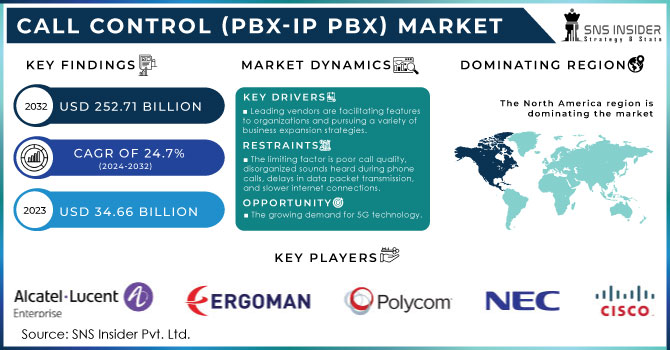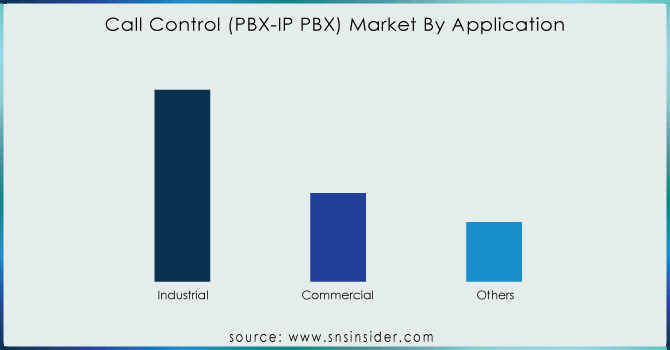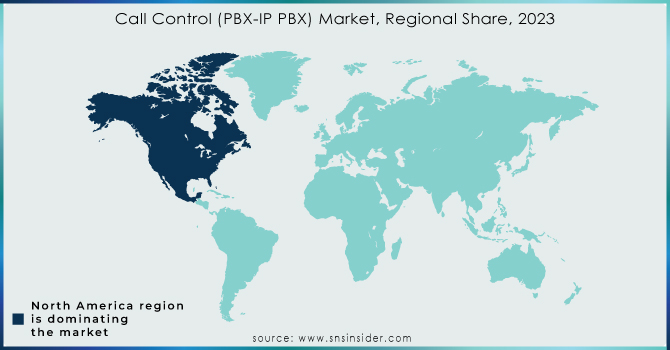Call Control (PBX-IP PBX) Market Size:

Get more information on Call Control (PBX-IP PBX) Market - Request Sample Report
The Call Control (PBX-IP PBX) Market Size was valued at USD 34.66 billion in 2023, and is expected to reach USD 252.71 billion by 2032 and grow at a CAGR of 24.7% over the forecast period 2024-2032.
The Call Control (PBX-IP PBX) market encompasses the provision of private branch exchange (PBX) systems, both traditional and IP-based, which facilitate call control and management within organizations. These systems manage calls, voicemail, and other communication features over data networks, offering scalability, mobility, and integration with various communication tools. Market drivers include the increasing demand for enterprise mobility and flexibility, the rise of cloud-based solutions, and the incorporation of advanced features such as auto attendants and video conferencing. However, challenges such as call quality concerns, security issues, and high initial investment costs pose restraints to market growth. Nonetheless, opportunities lie in the growing demand for 5G technology and expansion into emerging markets. Overall, the Call Control (PBX-IP PBX) market is expected to witness significant growth driven by technological advancements, changing work dynamics, and evolving communication needs in businesses worldwide.
Call Control (PBX-IP PBX) Dynamics:
KEY DRIVERS:
-
Leading vendors are facilitating features to organizations and pursuing a variety of business expansion strategies.
-
Enterprise mobility and flexibility, as well as cloud-based communication PBX.
Concerning enterprise mobility and adaptability, as well as the uptake of cloud-based communication PBX (Private Branch Exchange) systems, companies are increasingly acknowledging the significance of flexibility in their operations, enabling employees to work from any location at any time. Cloud-based communication PBX systems provide businesses with a cost-effective and scalable means of managing their communication requirements, facilitating functionalities such as voice calls, video conferencing, messaging, and collaboration tools. This transition towards cloud-based PBX systems underscores the rising trend of businesses embracing digital transformation and harnessing technology to bolster productivity and efficiency in today's workplace.
RESTRAINTS:
-
The limiting factor is poor call quality, disorganized sounds heard during phone calls, delays in data packet transmission, and slower internet connections.
-
Call feature failure, hearing a busy tone when employees or customers are not using their phones
-
Some of the security and privacy concerns restraining the market are incorrectly completed calls, audio issues, and poor quality.
Pertains to the challenges faced by communication systems, particularly in terms of poor call quality, which encompasses issues such as disorganized sounds, data packet delays, and slow internet connections, leading to an unsatisfactory user experience and hindering effective communication within organizations. Additionally, call feature failures, such as encountering busy tones despite phone lines being available, can disrupt workflow and cause frustration among employees and customers, potentially resulting in missed opportunities or delays in addressing critical matters. Furthermore, security and privacy concerns, including incorrectly completed calls and audio problems, not only impact user satisfaction but also raise apprehensions regarding the confidentiality and integrity of communications. Overcoming these challenges is essential for fostering trust and promoting the widespread adoption of communication technologies.
OPPORTUNITIES:
-
The growing demand for 5G technology.
-
Advanced communication system developments.
As the reliance on mobile devices and the expansion of the Internet of Things (IoT) ecosystem continue to increase, the demand for faster and more reliable wireless communication networks is growing significantly. The introduction of 5G technology is anticipated to provide ultra-fast data speeds, lower latency, and increased network capacity, making it suitable for supporting a wide range of applications, including autonomous vehicles, augmented reality, virtual reality, and smart cities. The deployment of 5G networks is expected to revolutionize various industries such as telecommunications, healthcare, manufacturing, transportation, and entertainment. This transformation will enable the introduction of innovative services and applications that were previously unattainable with current wireless technologies.
CHALLENGES:
-
The growing number of emerging market participants.
-
The growing competition from various products and services.
-
The deployment and maintenance of an on-premise PBX are both extremely expensive.
The increasing number of emerging market participants signifies the rise of new entrants into specific markets or industries. This phenomenon may be fueled by various factors such as advancements in technology, shifts in consumer preferences, or favorable market conditions. With the entry of these newcomers, competition intensifies as they endeavor to establish their foothold and capture market share. Moreover, the presence of emerging market participants can foster innovation and stimulate industry growth by introducing novel concepts, products, and services. Nonetheless, this trend also presents challenges for established players, compelling them to adjust their strategies to maintain competitiveness amidst evolving market dynamics. Ultimately, the proliferation of emerging market participants represents a pivotal force shaping the competitive landscape and trajectory of industries across diverse sectors.
IMPACT OF RUSSIAN UKRAINE WAR
The ongoing crisis poses several challenges for the PBX-IP PBX market, notably in terms of disrupted supply chains and economic uncertainty. With Russia and Ukraine serving as vital sources of raw materials and components for PBX systems, any disruption in the supply chain could lead to shortages and price escalations. Furthermore, heightened cybersecurity concerns stemming from the conflict could drive up demand for secure communication solutions, potentially benefiting the PBX-IP PBX market. However, economic uncertainty may dampen investments in new PBX systems as businesses adopt cautious spending approaches amidst uncertain market conditions. The regional impact of the crisis is expected to be more pronounced in areas heavily reliant on trade with Russia and Ukraine, potentially leading to increased market volatility and supply chain disruptions.
IMPACT OF ECONOMIC SLOWDOWN
The Call Control (PBX-IP PBX) Market is experiencing a complex impact from the prevailing economic slowdown, presenting a blend of challenges and opportunities. While some businesses may delay investments in upgrading call control systems, driven by economic uncertainties, the growing trend of remote work and digital transformation spurred by the pandemic is fueling demand for adaptable call control solutions tailored for distributed work environments. This shift notably benefits cloud-based and IP-based segments, renowned for their flexibility and cost-effectiveness. Additionally, market dynamics are influenced by factors such as global organization proliferation, technological advancements, and increased demand from emerging economies. However, challenges like poor call quality and internet connectivity issues constrain market growth. Moreover, ongoing geopolitical tensions, exemplified by the Russia-Ukraine War, add uncertainty and supply chain disruptions to the mix, potentially elevating manufacturing costs. Regional dynamics further shape the market, with developed economies leading in technology adoption while emerging markets show rapid growth fueled by digitization efforts and the emergence of SMEs.
Call Control (PBX-IP PBX) Market Segment Analysis:
BY PRODUCT
In the product segment, which encompasses IP extensions and TDM extensions, the market was primarily led by the TDM extensions segment of the market revenue. This dominance can be attributed to the substantial investments made by many organizations in TDM-based PBX systems. For these organizations, the cost of transitioning to IP PBX systems may be prohibitive. Nonetheless, the IP extensions category is experiencing the most rapid growth over the forecast period. In developing economies, this growth is fueled by the reliability, stability, and high-quality voice transmission offered by IP extensions, making them an attractive option for numerous organizations.
BY APPLICATION
In terms of application, encompassing both commercial, industrial sectors, and others the industrial category emerged as the highest revenue generator, constituting 70% of the total income. An IP PBX telephone system operates through an IP PBX server and functions over an IP network. The IP PBX telephone network is commonly utilized within industrial settings, as well as in public and industrial product emergency dispatch systems. However, the commercial sector is experiencing the most rapid growth, driven by the escalating demands within commercial operations and the rising necessity for call control (PBX-IP PBX) to efficiently manage peak requirements.

Need any customization research on Call Control (PBX-IP PBX) Market - Enquiry Now
Call Control (PBX-IP PBX) Market Regional Analysis:
The dominance of the North American call control (PBX-IP PBX) market region is anticipated due to the widespread adoption of unified communication technologies and VoIP technology across various major industries such as BFSI, hospitality, and healthcare, thus driving market growth in this area. Within North America, the US call control (PBX-IP PBX) market claimed the largest market share, while the Canadian call control (PBX-IP PBX) market exhibited the fastest growth. In Europe, the call control (PBX-IP PBX) market holds the second-largest market share, propelled by technological advancements and modernization in communication systems, alongside increasing demand from emerging economies within the region. Specifically, the German call control (PBX-IP PBX) market accounted for the largest market share, with the UK market showing the highest growth rate.
Conversely, the Asia-Pacific call control (PBX-IP PBX) Market is projected to witness the fastest compound annual growth rate (CAGR), attributed to the rising adoption of IP-based telephony and the demand for advanced features like call forwarding and voicemail within the region. China's call control (PBX-IP PBX) market held the largest market share, with the Indian market exhibiting the most rapid growth within the Asia-Pacific region.

KEY PLAYERS:
The key players in the Call Control (PBX-IP PBX) Market are Cisco Systems, Alcatel-Lucent Enterprise, NEC Corporation, Polycom LLC, ERGOMAN GmbH, Telus, Panasonic, Call Control LLC, EIL Global, Voxter & Other Players.
RECENT DEVELOPMENT
In February 2022: Atlantech Online announced the installation of fiber optics at Anthem Row. Tenants now have the opportunity to utilize Atlantech's Managed PBX Services to enhance their corporate infrastructure.
| Report Attributes | Details |
|---|---|
| Market Size in 2023 | US$ 34.66 Billion |
| Market Size by 2032 | US$ 252.71 Billion |
| CAGR | CAGR of 24.7% From 2024 to 2032 |
| Base Year | 2023 |
| Forecast Period | 2024-2032 |
| Historical Data | 2020-2022 |
| Report Scope & Coverage | Market Size, Segments Analysis, Competitive Landscape, Regional Analysis, DROC & SWOT Analysis, Forecast Outlook |
| Key Segments | • By Product (Tdm Extensions, Ip Extensions) • By Application (Industrial, Commercial, Others) |
| Regional Analysis/Coverage | North America (US, Canada, Mexico), Europe (Eastern Europe [Poland, Romania, Hungary, Turkey, Rest of Eastern Europe] Western Europe] Germany, France, UK, Italy, Spain, Netherlands, Switzerland, Austria, Rest of Western Europe]), Asia Pacific (China, India, Japan, South Korea, Vietnam, Singapore, Australia, Rest of Asia Pacific), Middle East & Africa (Middle East [UAE, Egypt, Saudi Arabia, Qatar, Rest of Middle East], Africa [Nigeria, South Africa, Rest of Africa], Latin America (Brazil, Argentina, Colombia, Rest of Latin America) |
| Company Profiles | Cisco Systems, Alcatel-Lucent Enterprise, NEC Corporation, Polycom LLC, ERGOMAN GmbH, Telus, Panasonic, Call Control LLC, EIL Global and Voxter. |
| Key Drivers | • Leading vendors are facilitating features to organizations and pursuing a variety of business expansion strategies. • Enterprise mobility and flexibility, as well as cloud-based communication PBX. |
| RESTRAINTS | • The limiting factor is poor call quality, disorganized sounds heard during phone calls, delays in data packet transmission, and slower internet connections. • Call feature failure, hearing a busy tone when employees or customers are not using their phones |

